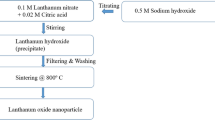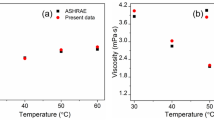Abstract
Low thermal conductivity is a primary issue in the development of efficient heat transfer fluids and materials required for the thermal management of various systems. In this work, beryllium oxide nanoparticles of size 15–25 nm and surface area 88 m2 g−1 were synthesized by polyacrylamide gel route to prepare nanofluid and nano-enhanced phase change material with enhanced thermal properties. The thermal conductivity and viscosity of the nanofluids show a linear increase with the BeO particle concentration, and a maximum thermal conductivity enhancement of 39% was obtained for 2 vol% nanofluid compared to its base fluid (deionized water). Similarly, the thermal conductivity, thermal diffusivity and latent heat capacity of the nano-enhanced phase change material were also found to be increased up to 15%, 30% and 23%, respectively, for 2 vol% BeO nano-enhanced phase change material compared to the base material (polyethylene glycol). The inferred results show that the BeO nanoparticle has a significant influence in the increased thermal properties of nano-enhanced fluids and phase change materials, and thus can be used as a potential heat transfer materials in thermal applications.
















Similar content being viewed by others
References
Wang X, Xu X, Choi SUS. Thermal conductivity of nanoparticle—fluid mixture. J Thermophys Heat Transf. 1999;13:474–80.
Shah J, Ranjan M, Davariya V, Gupta SK. Temperature-dependent thermal conductivity and viscosity of synthesized a -alumina nanofluids. Appl Nanosci. 2017;7:803–13.
Sun B, Liu H. Flow and heat transfer characteristics of nanofluids in a liquid-cooled CPU heat radiator. Appl Therm Eng. 2017;115:435–43.
Ho CJ, Gao JY. Preparation and thermophysical properties of nanoparticle-in-paraffin emulsion as phase change material. Int Commun Heat Mass Transf. 2009;36:467–70.
Choi SUS, Eastman JA. Enhancing the thermal conductivity of fluids with nanoparticles. ASME Int Mech En Congr Explos. 1995;1:1–7.
Mohamadian N, Ghorbani H, Woog D, Hormozi HK. Rheological and filtration characteristics of drilling fluids enhanced by nanoparticles with selected additives: an experimental study. Adv Geo Energy Res. 2018;2:228–36.
Genc M, Inci B, Genc ZK, Canbay CA. Preparation and investigations of thermal properties of copper oxide, aluminium oxide and graphite based on new organic phase change. Bull Mater Sci. 2015;38:343–50.
Lenin R, Dadwal A, Joy PA. Thermal conductivity studies on magnetite nanofluids coated with short-chain and long-chain fatty acid surfactants. Bull Mater Sci Indian Acad Sci. 2018;41:3–8.
Moghaddari M, Yousefi F. Syntheses, characterization, measurement and modeling viscosity of nanofluids containing OH-functionalized MWCNTs and their composites with soft metal (Ag, Au and Pd) in water, ethylene glycol and water/ethylene glycol mixture. J Therm Anal Calorim. 2018;3456789:1–14.
Abbasi S, Zebarjad S, Baghban S, Youssefi A. Statistical analysis of thermal conductivity of nanofluid containing decorated multi-walled carbon nanotubes with TiO2 nanoparticles. Bull Mater Sci. 2014;37:1439–45.
Leena M, Srinivasan S. A comparative study on thermal conductivity of TiO2/ethylene glycol–water and TiO2/propylene glycol–water nanofluids. J Therm Anal Calorim. 2018;131:1987–98.
Qiu L, Zhu N, Zou H, Feng Y, Zhang X, Tang DW. Advances in thermal transport properties at nanoscale in china. Int J Heat Mass Transf. 2018;125:413–33.
Qiu L, Zheng ZH, Su GP, Tang DW. Design and application of a free standing sensor based on 3ω technique for thermal conductivity measurement of solids, liquids and nanopowders. Int J Thermophys. 2013;34:2261–75.
Mehrali M, Sadeghinezhad E, Latibari S, Kazi S, Mehrali M, Zubir MNBM, et al. Investigation of thermal conductivity and rheological properties of nanofluids containing graphene nanoplatelets. Nanoscale Res Lett. 2014;9:1–12.
Gangadevi R, Vinayagam BK. Experimental determination of thermal conductivity and viscosity of different nanofluids and its effect on a hybrid solar collector. J Therm Anal Calorim. 2018;4:1–11.
Islam MR, Shabani B, Rosengarten G. Nanofluids to improve the performance of PEM fuel cell cooling systems: a theoretical approach. Appl Energy. 2016;178:660–71.
Sonage BK, Mohanan P. Miniaturization of automobile radiator by using zinc-water and zinc oxide-water nanofluids. J Mech Sci Technol. 2015;29:2177–85.
Rahimi MH, Jahanfarnia G, Vosoughi N. Thermal–hydraulic analysis of nanofluids as the coolant in supercritical water reactors. J Supercrit Fluids. 2017;128:47–56.
Kandasamy R, Wang XQ, Mujumdar AS. Transient cooling of electronics using phase change material (PCM)-based heat sinks. Appl Therm Eng. 2008;28:1047–57.
Souayfane F, Fardoun F, Biwole PH. Phase change materials (PCM) for cooling applications in buildings: a review. Energy Build. 2016;129:396–431.
Bose P, Amirtham VA. A review on thermal conductivity enhancement of paraffin wax as latent heat energy storage material. Renew Sustain Energy Rev. 2016;65:81–100.
Wang J, Xie H, Guo Z, Guan L, Li Y. Improved thermal properties of paraffin wax by the addition of TiO2 nanoparticles. Appl Therm Eng. 2014;73:1541–7.
Hamdan H, Ghaddar N, Ouahrani D, Ghali K, Itani M. PCM cooling vest for improving thermal comfort in hot environment. Int J Therm Sci. 2016;102:154–67.
Ghani S, El Bialy E, Bakochristou F, Gamaledin SMA, Rashwan MM. The effect of forced convection and PCM on helmets thermal performance in hot and arid environments. Appl Therm Eng. 2017;111:624–37.
Colla L, Fedele L, Simone M, Sergio B. Nano PCMs for electronics cooling applications. In: Proceedings of ASME 2016 5th international conference on micro/nanoscale heat mass transfer 2016, vol. 1, p. 1–10.
Sahan N, Fois M, Paksoy H. Improving thermal conductivity phase change materials—a study of paraffin nanomagnetite composites. Sol Energy Mater Sol Cells. 2015;137:61–7.
Shen S, Tan S, Wu S, Guo C, Liang J, Yang Q, et al. The effects of modified carbon nanotubes on the thermal properties of erythritol as phase change materials. Energy Convers Manag. 2018;157:41–8.
Han P, Zheng XH, Hou WS, Qiu L, Tang DW. Study on the storage and release characteristics of multi-cavity-structured phase change microcapsules. Phase Transit. 2015;88:1–12.
Tian H, Du L, Wei X, Deng S, Wang W, Ding J. Enhanced thermal conductivity of ternary carbonate salt phase change material with Mg particles for solar thermal energy storage. Appl Energy. 2017;204:525–30.
Buonomo B, Manca O, Marinelli L, Nardini S. Effect of temperature and sonication time on nanofluid thermal conductivity measurements by nano-flash method. Appl Therm Eng. 2015;91:181–90.
Kingery WD, Francl J, Coble RL, Vasilos T. Thermal conductivity: X, data for several pure oxide materials corrected to zero porosity. J Am Ceram Soc. 1954;37:107–10.
Wang X, Wang R, Peng C, Li T, Liu B. Synthesis and sintering of beryllium oxide nanoparticles. Prog Nat Sci Mater Int. 2010;20:81–6.
Kiran V, Krishnan M, Haribabu K, Vishnuprasad S. Green synthesis of copper oxide nanoparticles using Ixiro coccinea plant leaves and its characterization. Bionanoscience. 2018;8:554–8.
Mahian O, Kolsi L, Amani M, et al. Recent advances in modeling and simulation of nanofluid flows Part I: Fundamental and theory. Phys Rep. 2018. https://doi.org/10.1016/j.physrep.2018.11.004.
Sadeghi R, Etemad SG, Keshavarzi E, Haghshenasfard M. Investigation of alumina nanofluid stability by UV–vis spectrum. Microfluid Nanofluidics. 2015;18:1023–30.
Einstein A. Investigations of the theory of the Brownian movement. Dower Publ. 1956;322:549–60.
Ahammed N, Godson L, Somchai A. Effect of volume concentration and temperature on viscosity and surface tension of graphene–water nanofluid for heat transfer applications. J Therm Anal Calorim. 2016;123:1399–409.
Karami M, Akhavan-Behabadi MA, Raisee Dehkordi M, Delfani S. Thermo-optical properties of copper oxide nanofluids for direct absorption of solar radiation. Sol Energy Mater Sol Cells. 2016;144:136–42.
Zheng H, Wang C, Liu Q, Tian Z, Fan X. Thermal performance of copper foam/paraffin composite phase change material. Energy Convers Manag. 2018;157:372–81.
Li WW, Cheng WL, Xie B, Liu N, Zhang LS. Thermal sensitive flexible phase change materials with high thermal conductivity for thermal energy storage. Energy Convers Manag. 2017;149:1–12.
Author information
Authors and Affiliations
Corresponding author
Additional information
Publisher's Note
Springer Nature remains neutral with regard to jurisdictional claims in published maps and institutional affiliations.
Rights and permissions
About this article
Cite this article
Selvaraj, V., Morri, B., Nair, L.M. et al. Experimental investigation on the thermophysical properties of beryllium oxide-based nanofluid and nano-enhanced phase change material. J Therm Anal Calorim 137, 1527–1536 (2019). https://doi.org/10.1007/s10973-019-08042-w
Received:
Accepted:
Published:
Issue Date:
DOI: https://doi.org/10.1007/s10973-019-08042-w




